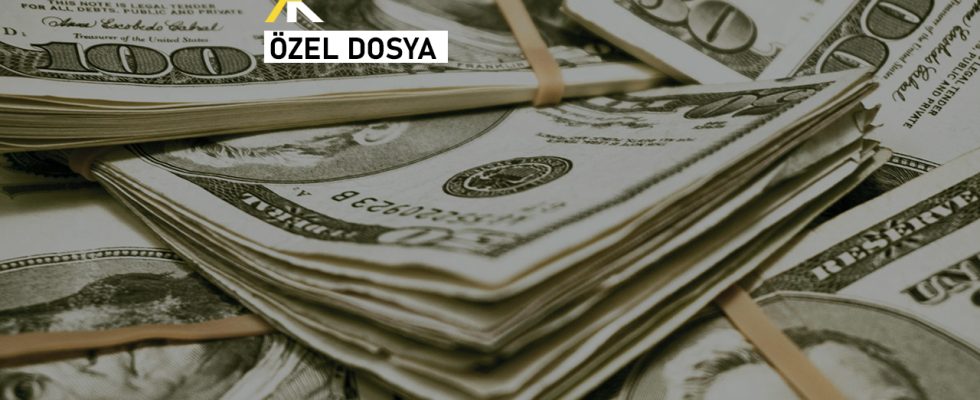Today, the US dollar is the number one reserve currency in the world. The appreciation or depreciation of this currency affects the economies of all countries as well as Turkey. The dollar, which has become the dominant currency in the world, is constantly in circulation in daily life. So much so that 62 percent of countries have dollars in their central banks.
The country with the most dollars in reserves in the world is China with 3 trillion 371 billion dollars, followed by Japan with 1 trillion 254 billion dollars and Switzerland with 898 billion dollars. As of June, the Central Bank of the Republic of Turkey has 108 billion dollars in reserves. So how did the US currency first appear? How did it become such a dominant currency?
It first appeared in Europe
Contrary to popular belief, the word dollar is older than the USA. Silver mined in the city of Joachimsthal (now Jachymov) in the Kingdom of Bohemia in what is now Czechia, was minted as silver coins in 1519. Joachimsthal, named after Saint Joachim in the Christian religion, means ‘Joachim’s valley’ in German. The minted silver coins became known as Joachimsthaller. It was later shortened to ‘thaler’. The word Thaler is the ancestor of today’s US currency.
By the mid-1500’s the thaler was now well known all over Europe. The Holy Roman-Germanic Empire, which ruled a large part of Europe at that time, was working on a currency with a standard size and silver content for the kingdoms within it. The empire chose the thaler as the standard currency and called all acceptable silver coins “Reichsthalers” (imperial thalers). This currency was later used by the Kingdom of the Netherlands as the leeuwen daalder (the lion thaler). Thaler was also used for a long time as currency in some provinces of Prussia and kingdoms in Scandinavia.
The emergence of the US dollar
As a result of geographical discoveries, the leuwendaalder of the European colonists and the Dutch spread to the Americas. Pronounced ‘dollar’ in Dutch, this currency began to be used among European immigrants. In fact, the Spanish peso or ‘piece of eight’ silver coins used in the Spanish colonies in the Americas began to be called Spanish dollars.

The USA, which had just gained its independence in 1792, chose the dollar as its currency. The symbol $, which is formed by superimposing the letters PS, which symbolizes the Spanish peso, began to be used as a symbol. A new mint was established in Philadelphia and began operations in 1794. The Mint was the first structure authorized by the United States government. However, due to the scarcity of both gold and silver, the amount of silver in money was reduced first in 1837 and then in 1853. The first paper banknote was introduced in 1862. In 1965, silver was completely removed from coins. The Spanish dollar, on the other hand, became history after Spain lost its colonies in the Americas.
The dollar prevails
The United States, which later joined the Second World War, was the supplier of weapons and goods to many countries during the war. Allied countries were making their payments to the USA in gold. The United States owned most of the gold in the world. This situation led the countries to deplete their reserves and the use of gold became impossible. Delegates from 44 allied countries met at Bretton Wood in the USA in 1944 to develop a system of foreign exchange management that would ‘do no harm to any country’. The delegation decided that world currencies would no longer be tied to gold, but would be pegged to the US exchange rate. From this date on, countries began to accumulate the US exchange rate in their central banks.
Today, besides the USA, many countries such as Canada, Australia, Singapore and Hong Kong use the dollar as their currency. Also, some countries such as Ecuador and El Salvador use the US dollar as their currency.
Sources: BBC, Exeter University, Wall Street Journal
Risk Disclosure: The articles and articles on Kriptokoin.com do not constitute investment advice. Bitcoin and cryptocurrencies are high-risk assets, and you should do your due diligence and do your own research before investing in these currencies. You can lose some or all of your money by investing in Bitcoin and cryptocurrencies. Remember that your transfers and transactions are at your own risk and any losses that may occur are your responsibility. Cryptokoin.com does not recommend buying or selling any cryptocurrencies or digital assets, nor is Kriptokoin.com an investment advisor. Therefore, Kriptokoin.com and the authors of the articles on the site cannot be held responsible for your investment decisions. Readers should do their own research before taking any action regarding the company, assets or services in this article.
Disclaimer: Advertisements on Kriptokoin.com are carried out through third-party advertising channels. In addition, Kriptokoin.com also includes sponsored articles and press releases on its site. For this reason, advertising links directed from Kriptokoin.com are on the site completely independent of Kriptokoin.com’s approval, and visits and pop-ups directed by advertising links are the responsibility of the user. The advertisements on Kriptokoin.com and the pages directed by the links in the sponsored articles do not bind Kriptokoin.com in any way.
Warning: Citing the news content of Kriptokoin.com and quoting by giving a link is subject to the permission of Kriptokoin.com. No content on the site can be copied, reproduced or published on any platform without permission. Legal action will be taken against those who use the code, design, text, graphics and all other content of Kriptokoin.com in violation of intellectual property law and relevant legislation.
